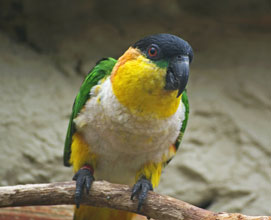
1.Right steps!
Scientists studying the black headed caiques have found that most of them are right footed, meaning that they prefer using that foot to handle food or toys. Even when the birds were offered a treat from the left side, they would turn to grasp it with their “stronger” foot.
2.Built for climbing.
3.Err, what did you say?
Caique chicks are practically deaf when they’re born. Their ear openings only develop about 3 weeks after they are hatched.
4.Birth order.
Caique eggs don’t hatch at the same time! Some birds can arrive as much as 2 weeks before their brothers or sisters. This makes it much easier for the parents to keep up with the demand of feeding them, and increases their chance of survival during “lean months” when food is scarce.
5.Vaudeville act.
Caiques are sometimes called dancing parrots because of their habit of hopping forward, scooting backward, and bobbing its head all throughout. With proper training they can hop on command. In the wild, however, the dance is the bird’s way of showing dominance or staking claim on its territory. (It’s bird Morse code for “This place is mine!”)
6.A caique by any other name….
In Brazil, the caique is called a tapir parakeet, or Periquito d’anta.
7.The Caique and the Pussycat.
British poet Edward Lear, who wrote the famous poem “The Owl and the Pussycat” was actually fascinated by parrots, and made a series of prints that included the white-bellied caique, which he labeled as “the bay headed parrot”. Only a few prints survive.
8.Distant cousins.
Some bird experts say that the caique is one of the most unusual birds in the sense that it bears very little resemblance or genetic connection to the other parrots. It’s almost a species in itself. So why do scientists say it’s a parrot at all? Aside from traits like the hook bill, the caique can also mate with other parrots—a subtle sign of affinity. (You’d never see a canary set up nest with a sparrow.)
9.Little helicopters.
Some caiques make a very unique whirring sound whenever they fly. Observers say that it’s almost like a helicopter.